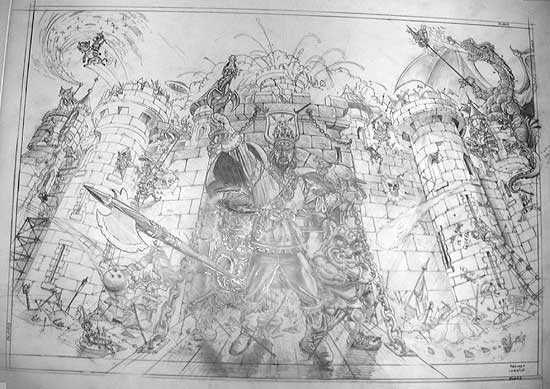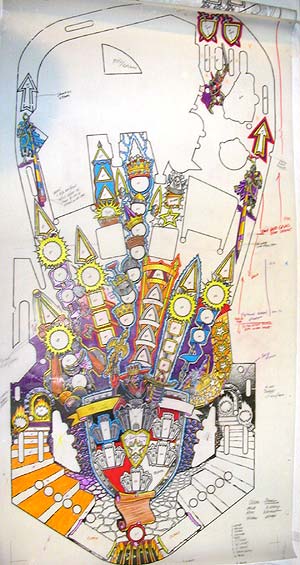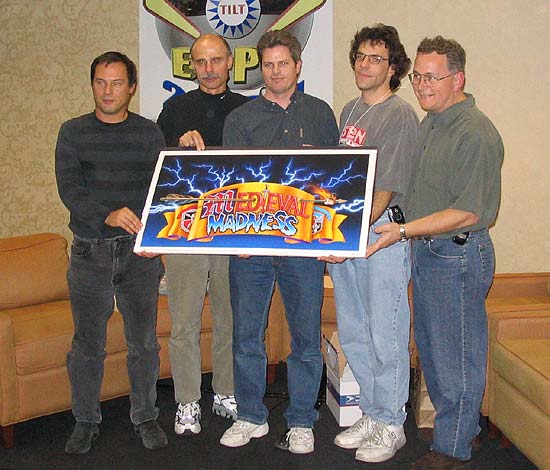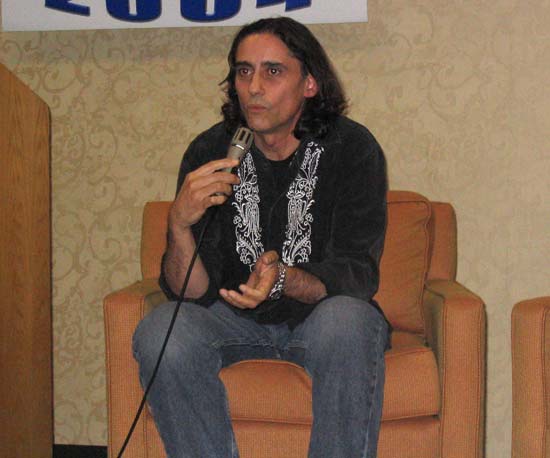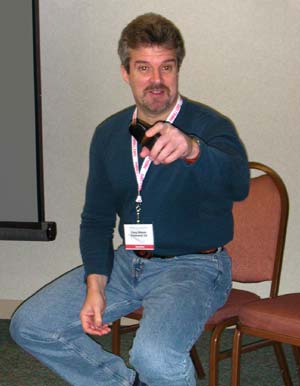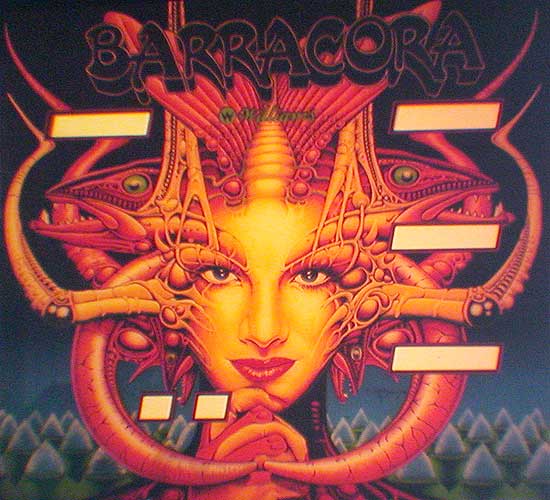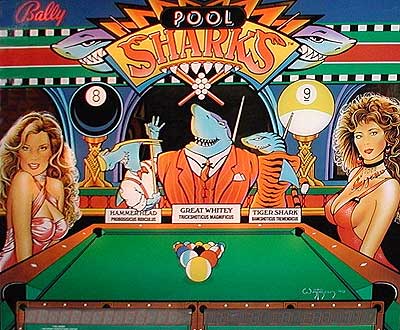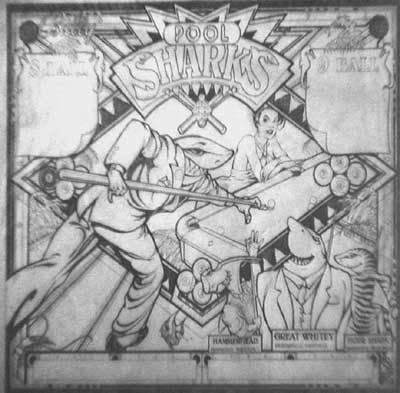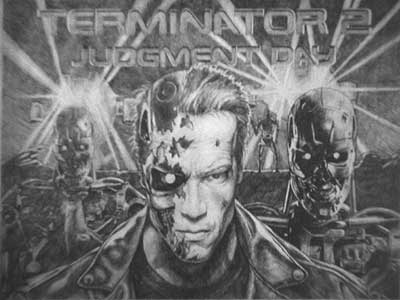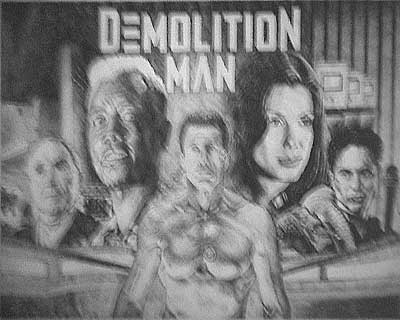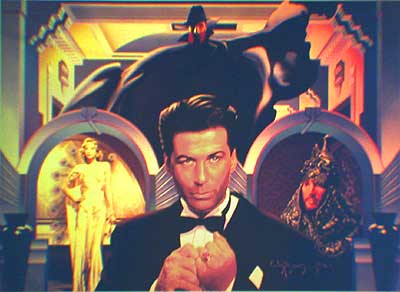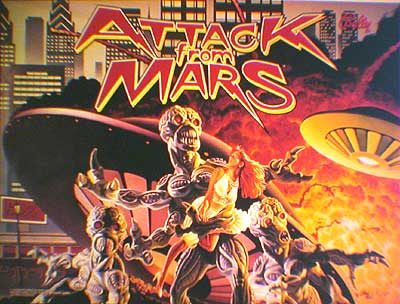
PINBALL EXPO 2004
|
January 5, 2005 We've reached the third part of our Pinball Expo - the fireside chats and the final seminar. The name of the fireside chat reveals its origin - a cosy, intimate discussion between the guest and the audience held in Expo organiser Rob Berk's hotel suite. Over the years these chats have become increasingly popular, which resulted in a crowded hotel room with some people unable to see or hear the guest, like in this chat with Larry DeMar last year. So this year the organisers bit the bullet and moved the chats into the ballroom - the same room used for the seminars. We'll see later how successful that decision was, but lets get on with the first guest. As last year, the fireside chat guests were introduced by Gary Flower.
Brian Eddy and Friends This fireside chat was based around one game - the most popular and valuable game of recent years - Medieval Madness. Designer Brian Eddy was joined by four members of the design team to the audience how the game came about, the design processes involved and how they view the game now. Brian began by explaining how he got a job at Williams in 1989, what he described as his dream job and made the move from Michigan to Chicago. He was 21 at the time and was into both pinball and video games so the job gave him the chance to work with the industry icons he had admired when he was growing up such as Larry DeMar, Eugene Jarvis and Steve Ritchie. He started by working on a couple of pinball games - Mousin' Around and Bad Cats doing some effect work before moving up to do all the programming on Pool Sharks and Swords of Fury. After that he worked with Python Angelo on The Machine - Bride of Pinbot, a game that gave Brian the chance to get more involved in the game and learn the emotional responses generated by playing pinball. Around this time, Brian also did some display and lighting effect work on Funhouse, working with Larry and Pat Lawlor - a time he says taught him a lot about the industry from the people who had made some of its greatest games. After that he worked with John Trudeau on Black Rose, his first dot matrix game which afforded him the opportunity to try some new ideas and led to his work with Mark Ritchie on Indiana Jones. On this game Brian said there was a really good team and one of his best experiences up until that time. Doug Watson was doing the art and the game had the new DCS sound system. It was a big game says Brian, a big licence with lots of modes and a lot of creativity.
By that stage Brian thought he had learned enough about the various disciplines to move up to game design. Ken Fedesna, the head of engineering at Williams gave him the opportunity to design his first game which resulted in The Shadow. Brian thinks he went slightly overboard on The Shadow by trying to put everything he could think of into one game which made it more of a challenge but he also programmed most of the game as well as designing it. It was a learning experience discovering what to put in and what to leave out to make great games in the future. The first of those games was Attack From Mars, the first time Brian and Lyman worked together. Brian found programming and designing on The Shadow was too much work so he was looking for someone to pull together the rules and programming together and make it special.
After that came Medieval Madness. Brian said all his experience until this point was put into the game - how to put a playfield together, how to make great shots and make them smooth and flow, and how to give the player a great emotional impact. Of course, Brian was also keen to stress how important the team was to the game's success. A team comprised of the best in the industry at the time, he said. After Medieval Madness, Brian moved over to video games - his other great love - at William's Midway Games. His first work there was on a game called Hyperdrive to get him up to speed on the state of the business and the type of work going on there. He then designed the arcade game Arctic Thunder - a sit down snowmobile racer. This was at a time when Midway decided to stop making arcade games to concentrate on Playstation 2 and X-Box consoles making Arctic Thunder their last arcade piece. For last next two and a half years Brian worked on Psi-Ops - The Mindgate Conspiracy which was released a few months ago, so he is now working on another project for Midway Games.
One of the tasks of the designer, he said, is to maintain the vision of the product - what is the game reall going to be and where will it go, drawing ideas and inspiration from the team to build the emotional impact of the game. Brian stressed how he wanted those emotions to be experienced not only by serious players but new players too, giving each of them something to continue playing for and that's one of the things that makes Medieval Madness such a fun home game. The rules also need to reinforce this with encouragement for achieving the game's goals with sound calls and cool effects to reinforce the value of the accomplishment and give the emotional rush to the player. Brian said they spent much of the development time making this happen. The number of toys on games of that era caused problems in Medieval Madness too. Brian explained how most games were given a year from the start of development until production started, but most of the work was in the last nine months. The exploding castle was the most intricate and difficult part to fit into the playfield and Brian wanted it to be its own little world within the game, so everything else had to wrap around it, not only above the playfield but with all the mechanisms below too. It was a challenge to get it all to work in the design phase but that was true in production also with the tolerances of the different parts making it a very tight fit.
Brian said that the castle exploding by itself wasn't really that special but when combined with the sounds, display and lighting effects it really conveys the sense of achievement to the player. Turning to the playfield models, Ray Kemper designed the castle while Expo seminar speaker Dave Link created the dragons and trolls. Brian said it was great fun working with these guys and producing the toys from scratch just for the game. He thought one of the areas people don't like about the game is the Merlin eject saucer because the ball sometimes falls out. Brian explained that sometimes in pinball design they didn't always do things because they thought they were the best but because they were constrained in some way, usually by cost. He said it could have been improved but to do so would have cost money that could be better spent elsewhere on the playfield. Cost is a constant battle for all game designers, especially during the '90s when more and more toys appeared on the playfield and they increased in complexity too as the designers tried to squeeze more into the game so players could get more out. Brian said he is pretty happy about the way the game turned out and judging by the aftermarket prices, others seem to like it too. He then passed the microphone to Dan Forden who spoke about the speech, music and sound effects in the game.
The Monty Python link continued with the game's main musical theme with triumphant trumpets, fanfares and a rumbling undercurrent of drums. For the speech, the team realised that they would need a lot of funny quotes in the game and also that weren't funny enough to do the work themselves, but Dan had been to see a show in Chicago by a group of performers called Second City which blew him away. So they approached two members of the group and got them to write and perform much of the speech in the game to flesh out some of the characters and create others. Scott Adsit was the voice of the King of Payne, Sir Psycho, the Duke or Bourbon and Merlin while Kevin Dorf voiced Howard Hurtz and the Earl of Ego. Tina Fey (from Saturdy Night Live) also appeared as two of the princesses (the Cockney one and the plump singing one) and the cackly old maid while Andrea Farrell was the Jewish American princess and the sexy princess. Greg Freres was the voice of the jousting announcer and one of the trolls while Francois Du Grim was Vince Pontarelli who also did the other troll. But not all the sounds they recorded made it into the game.
Working with the Second City group was so successful, they used them again in No Good Gofers to write and perform some of the voices. Since Williams' closure, Dan has been working at Midway on video games such as Mortal Kombat 4.
Referring to both Attack From Mars and Medieval Madness, he said Brian and he used to meet each evening to discuss how the game was going and what they should tackle next. Lyman said they knew in advance how most of the games' rules would work. Describing his usual way of programming a game, Lyman says he first tries to get the various toys working, so people could see what they do and the rules could be worked out.
He said Brian and he had created a base from which to build with their work on Attack From Mars. They wanted to evolve that game and create something new with Medieval Madness. It was also a different experience for Lyman as he was involved in the design process from the beginning unlike his earlier project. He said a lot of people looked at Medieval Madness and thought it looked a lot like Attack From Mars which he agreed with but thinks they are two very different games with Medieval Madness having a lot more entertainment value. One of the issues addressed in the later game was to make it possible to continue shooting at the central toy (castle) and destroy it during multiball, something only possible in AFM if you started the (saucer) mode before entering multiball. Lyman also spoke about some features which didn't make it into the game, such as the peasants wheeled up a trojan rabbit when you battle the King of Payne - another Monty Python reference. He said the humour in the game transcends language barriers with players in non-English speaking countries enjoying the quotes even though they may not fully understand them.
Asked if he could go back and make changes to the code and add some of those features, Lyman ruled out the possibility saying that he would have to go and work for WMS again to be able to do that and as he's working for Stern it simply wasn't going to happen.
Greg thought the idea could only work if it was given a humourous treatment and now thinks the game wouldn't have anything like the same appeal if it had been given a straight "swords and sorcerory" angle. His chosen approach was to work out sketches and concepts and take the role of an art director, bringing in John Youssi to create the final product. He parised John and said the two of them work realy well together with no egos getting in the way. He would produce the sketches and two days later John would have created the finished artwork. One of the most challenging parts of the game for the whole design team was the castle and it caused some artwork problems too. Greg worked with the sculptor to design the castle and shape the turrets with the intention of making it look evil through the use of skulls embedded in the castle walls along with the family shield. But for Greg, the biggest challenge was to find a name for the game. Early options included Black Evil Castle, Baron von Badguy and Black Thursday.
Once Greg has produced a basic layout of the backglass with the king, the castle and the trolls he passed it over to John to produce the full colour image. The challenge then was think of the humerous references to include in the artwork, so they sat down and drew up a list of funny things they could put in - things John would have to put into his finished product. Greg's last pinball project was Revenge From Mars and has recently been working for Brian again, this time at Midway Games on Psi-Ops: The Mindgate Conspiracy.
Greg had already done the preliminary sketches for the backglass and John took those to produce monochrome and colour versions of his completed artwork for that and the cabinet. He tried to get as many of the original ideas into the backglass as possible from the long list provided by the team, only missing out a few such as a snake on the drawbridge chain and ducks in the moat. John also added one idea of his own - football players throwing Gatorade over the wall. He brought along a selection of artwork from the game showing how it developed from early ideas to completion.
John said the game was a lot of fun to work on and he has many happy memories of that time. He is currently working on slot machines for IGT but still does pinball art for Stern such as Ripley's Believe It Or Not!
After Medieval Madness, Brian went to work on video games for Midway but still had some involvement when George Gomez designed Revenge From Mars on the Pinball 2000 system. He was proud that their first game to showcase the system was a sequel to his Attack From Mars game. Talking about the design process for Medieval Madness, Brian said the ramp positions didn't change much from his first mock up to the final version but he did move the central elements around to get the moat and lock shots to work. He really wanted to include the lock shot but it didn't fit easily and ended up being the tightest shot on the playfield. He reiterated the lament of most deigners that you never have enough time to put all the elements you want into a game before it has to start production and ship. Lyman agreed saying they were producing "disposable software", code that was written for the game and once it went into production there was no real need to go back and change anything or fix bugs. In his case though, he did go back and fix the bugs or tweak features for him and his friends who noticed them, whereas most of the rest of the world didn't care. He though if Williams hadn't closed down their pinball division he may have gone back to add some of the features that didn't make it into the original code. Brian spoke about the split ramp design introduced on Medieval Madness to stop a failed ramp shot draining straight down the middle. He said he tried several different methods to prevent this but came up with the split ramps as a simple and effective solution - a solution patented by Williams. When designing games, Brian said he always had to be mindful of the space taken up by the mechanisms mounted under the playfield because they limit the number of toys you can put into a game. As an example, he said it was his intention to have pop up Mongol warriors in The Shadow but there wasn't enough room under the playfield for the mounting hardware so they were dropped, to reappear as Trolls in Medieval Madness. His budget for Medieval Madness was about $1400 most of which went on standard game parts like the cabinet and the electronics leaving just over $200 for the playfield so there was always a balance between adding more toys and their cost. One reason drop targets were rarely seen on games of that era was their cost - money which could be spent on bigger, better and more toys. Brian said he had to fight for every extra dollar, something some other designers seemed to find much easier. The choice of a ball launch button instead of a plunger saved $5 which meant there could be a dragon on the playfield.
He was asked if he would be interested in creating a sequal to Medieval Madness and replied that he prefers original themes with new ideas to going over old ground again. But Brian also thought there would have been a sequel around 4 or 5 years later if he and Williams had both stayed in pinball. Looking at things he would have changed, Brian cited the Merlin saucer as the one part of the game he wished he'd had the time to develop to make it more reliable. It was problematic on Attack From Mars and he tried to improve it for Medieval Madness and at the same time save money but introduced a different problem. There were some plastic protectors supplied with the game to prevent balls getting stuck in the castle towers. Brian said he didn't believe a ball could ever get there but received complaints from German distributors who find numerous ball hang ups and report them back to Williams, so they included the protectors in the coin box but didn't fit them as standard as they looked ugly. Considering the state of pinball now, Brian said he wished he knew how to bring pinball back into the public consciousness because he had a great time working in pinball in what he thinks was its heyday - a time when Williams could produce games with lots of toys and complex rules. He said he thought the use of humour in the game broadened its appeal and gave it a much wider audience than games with a more serious and concentrated treatment, making it more accessible to new players. Referring to the internet petition asking Gary Stern to emply him to design a game, Brian said he was very flattered and thanked everyone who had signed it but nothing had come of it and the one thing he is short of right now is time. He didn't rule out the possibility of working for Stern saying he has a lot of ideas but he didn't expect anything to happen in that area. Brian was asked if he was disappointed that Medieval Madness only sold 4000 units when it was (and still is) clearly such a popular game. He replied that pinball was definitely in a downturn by that stage and operators were reluctant to buy new games. Larry DeMar spoke from the audience saying he championed the game with the management of the company saying they should keep it on the production line much longer because the game was hot and there was the demand out there but the decision was taken not to make any more and start production on Cirqus Voltaire which he described as a much weaker game. He said the only other time he was similarly overruled was on Attack From Mars. The business at that time required around 3,300 sales of each game (with three games a year) to keep the company profitable. To close the fireside chat, all the former Williams employees in the room came together.
George Gomez George has a special place in the heart of Pinball Expo attendees. It was he who spoke at a seminar in 1999 about Pinball 2000 and told the audience how he feared the platform would never get the chance it deserved to fully develop. He was very downbeat about Williams pinball division's future - a sentiment borne out a few days later when its closure was announced. So, we can trust George to tell it like it is.
The audience had been primed by Steve Ritchie and Ray Tanzer to fire rubber bands at George as he began to speak. In retaliation, George showed this cartoon by Pat McMahon of Steve as a slot machine designer.
When he left college George got a job working for Midway, originally in the mechanical engineering department making control interfaces and cabinets and later working on video game design. He worked on the Spy Hunter video game developing software and designing controls. At night, he used to head over to the pinball division and play their Firepower 2. He spent seven years in the video game department but wanted to make something more tangible and real, so he left to become a toy designer. George played a slideshow of some of the toys he designed including Crash & Bash (trucks that would crash into each other with various parts flying off) and Wearable Warriors ( a range of hi-tech watches and other jewellry with built-in gimmicks and characters). He said this work was fun and paved the way for this later work designing pinball as he could understand how mechanisms worked and put things together.
Later, Incredible Technologies hired George as an independent contractor to design Battle Tech centres - arcades where you could play games against fellow players - for a client of theirs.
He came up with this concept for the player pod which was installed in their locations for six months until the client company's constant late or non-payments caused George to leave. He then designed a number of novelty games for Bromley, one of which was noticed by Pat Lawlor and Larry DeMar at an AMOA trade show. That recognition was to prove valuable a couple of years later when a position opened up at Williams for a novelty game designer. Also while making novelty games for Bromley, George was at an arcade when they brought in a Terminator 2 pinball on test. He was getting frustrated with the restricted number of features he could put in his games so when this new pinball showed up he tried it and realised he could design these games too.
One of George's early design ideas was a 3D version of Steve Ritchie's Hyperball game, where small plastic balls could be shot through the air at a series of targets, either as a single player or head-to-head game.
When designing, whether it is a single part or an entire game, George likes to sketch his plans as a way of trying out concepts. He said he doesn't always know where he's going with an idea but sketching it usually helps clarify matters. As an example, he showed this preliminary sketch of Lord Of The Rings.
There are some obvious differences to the final game with the ring in the centre of the playfield and no Paths Of The Dead upper level but the sword lock and falling tower were included.
There was also no Balrog guarding the centre ramp. His part is taken by a cave troll hiding behind some rocks.
Before he started designing Lord Of The Rings, George wasn't a fan of the books but was working with several people who were exceptionally familiar with the theme. George read the books and watched the movies to familiarise himself with the subject of his game.
Turning to internet reviews of his games, George said that despite not wanting to be influenced by the online comments, he usually found it impossible not to read what people are saying about his games when they go out on test. Sometimes, he said, those comments are right on the money but other times he has to just roll his eyes. One comment that particularly infuriated him was a suggestion that Monster Bash - his personal favourite - was a rip-off of Attack From Mars. Saying that he had been waiting since 1999 to do this, he showed the AutoCAD drawings of the two games side by side to illustrate the lack of similarity.
Looking at the Pinball 2000 platform, George said he didn't know how it could have developed because there were many ways for it to move forward. As one of the originators of Pinball 2000, he said they completely redesigned everything in a pinball game except the flippers in just nine months and he thought it could have gone way beyond what the first two games did. Interestingly, he said that he didn't intend Pinball 2000 to replace the traditional style of pinball but to run alongside it, giving Williams two product lines. Describing the product launch at ATEI in London in 1999, George admitted that the team wasn't ready and there were still a large number of bugs in the game which caused it to crash on the show floor despite spending days and nights working on the system in the days running up to the show. He said the operating system was completely new and many of the programmers were not used to thinking in the certain way the system demanded. The company sold a large number of Revenge From Mars games and George mused if they had sold more Star Wars Episode One games the company may have taken a different view and not shut down the division. Turning to Monster Bash, George said it was one of those situations - and you can't plan it - where you have the right team, the right energy and everything just comes together. The team decided early on not to try to make the monsters scary because they just weren't anymore, so they would make them funny instead and put them in a situation to tie in with the music in the game. Hence, they put them in a rock band and sent them on tour. George loved the way he could play with the characters, despite them already being established, and give them personality traits to fit in with the game.
Playing with the characters in this way required a cooperative licensor, and George described Universal Studios as very forgiving. Roger Sharpe (in charge of licensing at Williams) spoke from the audience and explained how Universal were in the process of re-launching the monsters and wanted to keep them pure to the original concepts when along came Williams wanting to put them in a rock band. There was a division of opinion at Universal, some wanting to stay true to their origins while others wanted to go with the rock band idea as a way to re-energise the brand. After seeing the games and getting approval from other licensees, they gave their permission. George described the amount of engineering time spent trying to get the best from the phantom flip feature. This was one of Lyman Sheat's pet projects and he had George try numerous different inlane switch combinations to get the most reliable results. He estimated a third of the engineering time was spent on this one feature. Moving to more recent events, George said he was approached by Stern and asked if he would do a game for them. He agreed if it was on his terms, meaning he couldn't work at Stern full time because he already has a full-time job leading a video game design team for Midway, so would have less involvement in the overall project. They agreed and Playboy was the result, followed by Lord Of The Rings. It means that George delivers the playfield sketch and other information about the layout and three weeks later Stern guys call him and invite him back to look at the result. He says he misses the team spirit, the hanging out and the practical jokes because he's not there very often. It's almost like a hobby for him now although it remains fun. Finally, there was a gathering of all the people in the audience who had worked with George at Midway, Williams or Stern.
So that concludes our report from the two fireside chats. It's clear that they have outgrown the confines of Rob's hotel room but in moving to the Grand Ballroom they have also lost much of the intimacy and become more like seminars which is a shame because part of the attraction of the format was the informality, most of which has been lost. But that said, this year's guests provided some excellent entertainment and some interesting insights into the design processes and methodology from some of pinball's greatest designers of recent years. But that wasn't the end of the talks because squeezed into the schedule on Saturday afternoon was a late seminar by another great pinball artist.
Doug Watson
When Doug started, all the printing for the pinball companies was done by a company called Advertising Posters who had serviced the pinball art market for 40 years until Bally got their own printing up and running in the 70s. Gottlieb hired Doug out of college because Paul Farris at Bally was creating great art on games such as Lost World and Paragon and Gottlieb wanted someone to do the same kind of work for them. Doug's early work for Gottlieb caused some controversy with his use of naked or semi-naked women which the company deemed too extreme for them and had some it reworked by another artist. After moving to Stern, Doug's first game there was Quicksilver designed by Joe Joos. In those days there was no contact between the game designer and the artist. The artist would receive the playfield and their job was to decorate it. To learn how to create pinball art Doug turned to a man who worked at Advertising Posters called Gordon Morrison. He was the only person working on the art for Gottlieb and he created it for hundreds of Gottlieb games. Gordon taught Doug the golden rules of pinball art, the first of which was "you can't use the colour green". Being used to painting, Doug was incredulous and determined to disprove this notion, so on Quicksilver he made all the artwork green. It was at this time that Advertising Posters were trying to get some work from Williams as they were trying to get something different to the work of Connie Mitchell on games such as Stellar Wars and Firepower, something more illustrative. So they held talks with Advertising Posters and Doug to come up with an alternative.
Doug spent months dreaming up an idea and this Barracora backglass was the result, using Brooke Shields as a model for the face. The game was originally called Barracuda but Ken Fedesna at Williams disliked the name, saying it had negative connotations as it was released fairly soon after the movie Jaws. Doug says he suggested the alternative Barracora name and it was quickly approved. When he wasn't creating artwork for Advertising Posters, he was designing pinball game ideas he wanted to do such as big game dinosaur hunting, a spider game called Black Widow and one based on time travel. Doug continued design work for Williams with his next project Fireball 2. The original artwork for Fireball was by Dave Christensen which Doug described as "one of the most perfect, striking graphic art images ever done for a pinball machine... It was just beautiful." But Doug had to redo it in his own style using more muscle and aggression. Of all the different elements of his artwork, the one area of which Doug is most proud is his game titles. He really enjoyed that aspect and had fun playing with the logos. For Steve Ritchie's game High Speed 2: The Getaway, the logo is prominent on the backglass and forms most of the cabinet artwork too. Doug wanted to increase the adrenaline from Python Angelo's original High Speed backglass so he added Apache attack helicopters with loads of missiles and guns.
The next game Doug spoke about was Pool Sharks. This backglass was a combination of line art and painting but that's not how it started out.
This was the design Doug wanted to use for the Pool Sharks backglass.
Referring to his Cybernaut backglass, Doug said it was the first chance he had to simply paint and he considered himself incredibly lucky to be able to do that and get paid for it. He said "science fiction, fantasy, babes, creatures... how could you go wrong?" Doug chose the title for the game and the model for the backglass was Sharon from the Bally factory.
Swords of Fury was another of Doug's games. The team were handed the playfield design and decided to give it a Dungeons & Dragons theme but without using that licence. Once again, Doug did a scarier version which was rejected in favour of this friendlier version. Another strong logo design sits above a creature not unlike the Balrog from The Lord of the Rings which was to figure later in his career after he left Williams and worked on video games including The Lord of the Rings: The Two Towers for the Playstation 2. Doug also spoke about the creative freedom the design teams had at that time, a time before licensed themes became more prevalent. Essentially, they could design a game around any theme they wanted limited only by their imagination, something he was very fortunate to experience. Glass was sometimes used for backglasses when they wanted a mirror effect but it was not well suited to the four colour printing process they used because of the inconsistencies of colour reproduction. Despite this, Doug wanted to use mirrored glass for Pool Sharks since it fitted in well with the theme of a pool hall. The printing process works better on Lexan which is also used but it can't be mirrored. Doug's first game with Steve Ritchie was F14-Tomcat and he said he wanted to make the backglass as exciting, explosive and in-your-face as Steve's games were to play. Plus it gave him the opportunity to paint a backglass, something he had been longing to do. One of the games he most enjoyed working on was Terminator 2. Doug went to the Hollywood premier and started to get involved more in the design of the game and not just putting artwork on it. As a player, he was concerned how difficult playfields were to understand with the fine print and the studying required to work them out, something that got worse in the 90s. He sees T2 as a turning point where players could instantly understand what they had to do just by looking at the playfield through the use on incremental inserts on the main shots and pointer arrows. He was at pains to point out how he didn't use shots from the movie on the playfield but made it the cleanest and easiest to understand with simple colours and bright colours against gray to help you intuitively find the shots.
This original sketch of the T2 backglass was rejected by Arnold Schwarzenegger because it didn't show the signature version of him from the movie wearing dark glasses and a leather jacket. The trouble was, Doug didn't have any reference for that in his promotional material and the impact would be totally lost if you couldn't see the eyes of the main figure in the image. So he painted over the character on the right with another Arnie, this time wearing sunglasses made up by Doug. Doug worked with Dennis Norman on the game Demolition Man but described it as the biggest nightmare of his life. The problems stemmed from the movie production company and specifically the producer Joel Silver. He had to make eleven backglass sketches before one was approved. The previous efforts were rejected without explanation so that by the time a version was approved, Doug's time to work on the project had ended and he passed it on to Linda Deal to complete. He said he really wanted to paint Stallone's face with all the character it contains and it bugs him that he never got to do it. The problems appeared to come from Wesley Snipes who didn't like his image to be less prominent that Stallone's in the earlier versions although in many ways it is more dominant in this example. He also didn't want to be portrayed as the crazy, frenzied murderer he plays in the movie.
Doug described the backglass as his first foray into the world of multimedia. Parts were oil painted, others were airbrushed while still others were drawn with coloured pencil for fine detail. Moving on to Indiana Jones, he said the game was all about trying to cram as many different modes as possible into one pinball game - twelve in all - because they had the licence to use all three movies. Doug said the game's designer Mark Ritchie allowed him to design the layout of the inserts on the playfield to make it as comprehensible as possible, choose the mode names and work with the programmers to decide what would happen in each mode. He said the design team tried to throw everything possible into the game but what tied it all together was the soundtrack and the movie theme music. Over time, Doug became more and more interested in the design of games and the feel of the shots, so he wanted to participate more in the game design process of thinking up rules and themes. In short, he wanted to be a game designer. About six months before he left Williams, Doug created a whitewood for his first game but nothing ever came of it. His all time favourite game is Attack From Mars. Doug said he had the most wonderful time working with Brian Eddy creating the game.
Some people think Attack From Mars was deliberately brought out around the same time as the movie Mars Attacks but Doug insists it was just a coincidence. The movie company found out about Williams' plans and pursued Doug to see if he was infringing on their copyright. So he had to fill out pages of descriptions about how the Williams Martians differed from the movie company's Martians and the game differed from the movie storyline. Eventually they accepted the obvious differences of the Martian's scale, scariness and build and the game's provenance in the 1950s Martian movies. Doug created the oil painted backglass scene using pictures of Martian models he made, posed and lit along with a picture of a secretary at Williams dressed up in a Marilyn Monroe dress. He said if he was doing it now, it would be much easier to recreate the scene in a 3D package. Doug's last work for Williams was for a redemption game designed by Steve Kordek called Ticket-Tac-Toe. He said in conclusion that drawing this stuff is nothing but a pile of fun. If you can find a job as fun as this you've got it made and he had it made for almost seventeen years. Making computer games doesn't hold a candle to it.
So that conculdes our look at the seminars and fireside chats. In the final part of our Expo coverage we'll go into the exhibition hall to look at the games and vendors, head off to the banquet to hear the speakers and finally report from the tournament to see who was crowned Pinball Wizard. Thanks to Richard Wade for additional photography.
© Pinball News 2004 |
||||||||||||||||||||||||||||||||||||||







